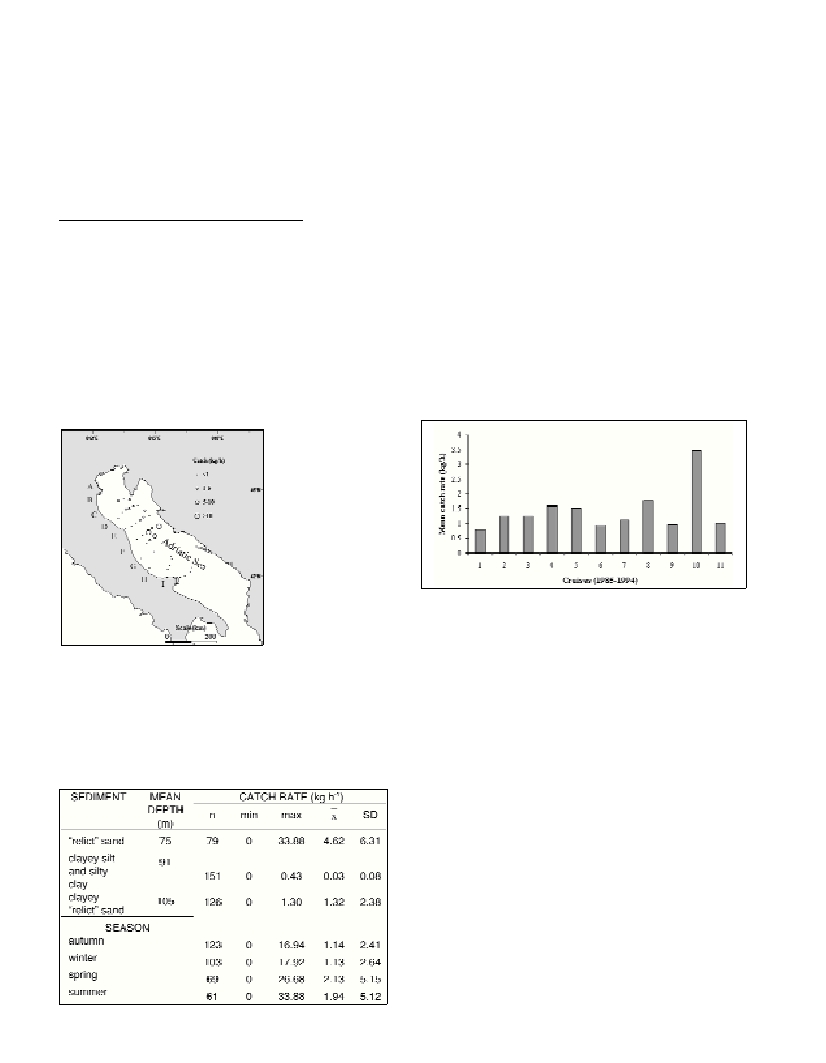CATCHES OF THE HOLOTHURIAN STICHOPUS REGALIS(CUVIER, 1817)
DURING THE “PIPETA” EXPEDITION IN THE ADRIATIC SEA
Marija Despalatovic*, Ivana Grubelic and Ante Šimunovic
Institute of Oceanography and Fisheries, Šet. I. Meštrovica63, 21000 Split, Croatia - mare@izor.hr
Abstract
We present data on the abundance of the holothurian Stichopus regalis(Cuvier, 1817) on the continental shelf of the Adriatic Sea during
11 cruises of the “Pipeta” Expedition (1985-1994). A total of 518 bottom trawl hauls were performed covering an area of approximately
59,000 km
2
of different substrata at different depths. The greatest catch rate (33.88 kg h
-1
) of the species was recorded at 105 m and on
“relict” sand sediment.
Keywords: Stichopus regalis, catch, Adriatic Sea
Rapp. Comm. int. Mer Médit., 37,2004
345
Introduction
Bottom trawl by-catch was recorded for the first time during the
“Pipeta” Expedition in the Adriatic Sea. The holothurian Stichopus
regalis(Cuvier, 1817) is a common species in trawl by-catches from
the continental shelf in the Adriatic (1). It is an edible species but not
consumed in the Adriatic region. Here, we present the species catch
rates based on the “Pipeta” Expedition results.
Material and methods
Samples were collected during 11 cruises of the “Pipeta”
Expedition (1985-1994) with standard Italian bottom trawl (2) during
different periods of the year. Trawling was performed on 10 transects
(A-L) (Fig. 1) over the Adriatic continental shelf, at depths 10-430 m,
covering an area of about 59,000 km
2
of different substrata. Catch
rates per station were expressed as mean kg h
-1
of trawling.
Fig. 1.
Catch rates (kg h
-1
)
of the holothurian
Stichopus regalis
during the “Pipeta”
Expedition
(1985-1994) along
10 transects in the
Adriatic Sea.
Results and discussion
A total of 518 bottom trawl hauls were performed during 1985-
1994. To calculate mean catch values at different substrata, 356 hauls
were used from the area of its distribution (i.e., stations where the
species was caught at least once). The greatest mean catch rate of
Stichopus regaliswas recorded at depths 50-100 m, whereas it is
normally distributed at depths 5-470 m (3). The highest mean catch
rate (4.62
±
6.31 kg h
-1
) was recorded at stations with “relict” sand
(Table 1). On clay silt and silty clay sediments, its presence was
negligible being in accordance with previous data (1). Generally, the
mean catch rates at the stations of each sediment type differed
significantly (ANOVA, P<0.01). Furthermore, the high standard
deviation values of the means (Table 1) denote the uneven species
distribution in the area. The species was not caught at stations on
transects “A” and “B”. The greatest catch (33.88 kg h
-1
) was recorded
on transect “F” (Fig. 1), in the area where Šimunovic(1) recorded 940
specimens per hour, while very small catches along the “H”, “I” and
“L” transects. The mean catch rates of S. regalis during 11 cruises did
not differ significantly (ANOVA, P>0.1) (Fig. 2). Finally, the mean
catch rates did not differ with season (ANOVA, P>0.1) (Table 1).
Fig. 2. Mean catch rates (kg h
-1
) of the holothurian Stichopus regalis dur-
ing 11 cruises of the “Pipeta” Expedition (1985-1994) in the Adriatic
Sea.
References
1-Šimunovic A., 1997. Quantitative and qualitative investigations of
benthic communities in the areas of mobile bottoms of the Adriatic Sea.
Acta Adriat., 38: 77-194.
2-Piccinetti C., 1972. Catalogue of fishing gear designs. FAO, London,
42 p.
3-Zavodnik D., and Šimunovic A., 1997. Beskralješnjaci morskog dna
Jadrana. Svjetlost, Sarajevo, 217 p.
Table 1. Mean (±SD), range (min-max) and number (n) of the holothuri-
an Stichopus regalis trawl catches (kg h
-1
) at different sediment types
and seasons during the “Pipeta” Expedition (1985-1994).

